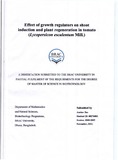| dc.contributor.advisor | Seraj, Dr. Zeba Islam | |
| dc.contributor.advisor | Islam, Dr. Aparna | |
| dc.contributor.author | Das, Amitav | |
| dc.date.accessioned | 2012-03-14T05:49:26Z | |
| dc.date.available | 2012-03-14T05:49:26Z | |
| dc.date.copyright | 2011 | |
| dc.date.issued | 2011-11 | |
| dc.identifier.other | ID 08276001 | |
| dc.identifier.uri | http://hdl.handle.net/10361/1666 | |
| dc.description | This thesis report is submitted in partial fulfillment of the requirement for the degree of Masters of Science in Biotechnology, 2011 | |
| dc.description | Cataloged from PDF version of thesis report. | |
| dc.description | Includes bibliographical references (page 35-42). | |
| dc.description.abstract | Tomato (Lycopersicum esculentum Miller) is one of the most important winter vegetable crops in Bangladesh. To meet the increasing demand of tomato in Bangladesh, it is necessary to develop new varieties adapted to various abotic and botic stresses. To achieve high yield potential and wide adaptability, tissue culture may play a role. For this, it is necessary to investigate the effect of growth regulators on shoot induction and plant regeneration in tomato. In this study four locally grown tomato (Lycopersicon esculentum Mill.) varieties, namely. BINA-3, BARI-3, Bahar, Maple and one Indian commercial variety, Pussa Rubby (PR) were selected to observe the effects of growth regulators on plant regeneration in tomato. Cotyledonary leaf explants of tomato were collected from 8-10 days old in vitro germinated seedlings. Different concentrations and combinations of growth regulators were added to MS
media to observe shoot initiation and root induction. Among all the combinations, MS media containing 1.5mg/I BAP and 0.2mg/I IAA showed best result with lowest callus formation and increased number of shoot in all the varieties. In this medium the best response was found for Maple (93.33 %) followed by Pussa Ruby (86.67 %) and for the other varieties such as BARI-3, BINA-3 and Bahar gave almost similar response to that combination of the medium. The survival response of all varieties was in between 80 % to 90 %. Among the varieties, Maple showed the best survival response which was almost 90 % while BINA-3 showed the survival response of almost 80 %. Among all the varieties, BINA-3 showed highest number of fruits per plant while 131NA-3 and BARI-3 showed highest average number of seeds per fruit.
Viability response of all the five varieties was in between 75 % to 82.5 %. Among the varieties. BINA-3 showed the best viability response which was almost 82.5 % while Maple showed the viability response of almost 75 %. Finally this study has shown that 1.5 mg/I BAP with 0.2mg/I IAA containing MS media is better for shoots induction and 0.2mg/I IAA containing '/2 strength MS media showed best response to root formation for all the five varieties. Each experiment was conducted three times (n=3). Regeneration percentages were analyzed by using SPSS version 16 and significant differences among means were assessed by the Duncan test (P <0.05). | |
| dc.description.statementofresponsibility | Amitav Das | |
| dc.format.extent | 42 pages | |
| dc.language.iso | en | en_US |
| dc.publisher | BRAC University | en_US |
| dc.rights | BRAC University thesis are protected by copyright. They may be viewed from this source for any purpose, but reproduction or distribution in any format is prohibited without written permission. | |
| dc.subject | Biotechnology | |
| dc.title | Effect of growth regulators on shoot induction and plant regeneration in tomato (Lycopersicon esculentum Mill.) | en_US |
| dc.type | Thesis | en_US |
| dc.contributor.department | Department of Mathematical and Natural Science, BRAC University | |
| dc.description.degree | M. Biotechnology | |

